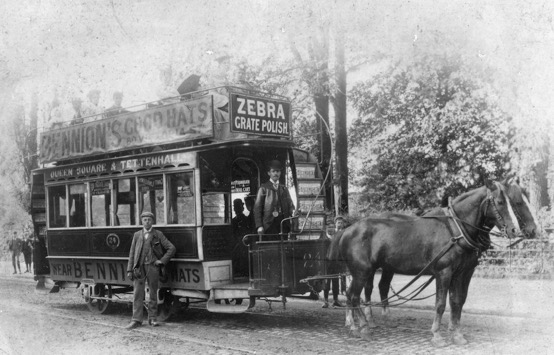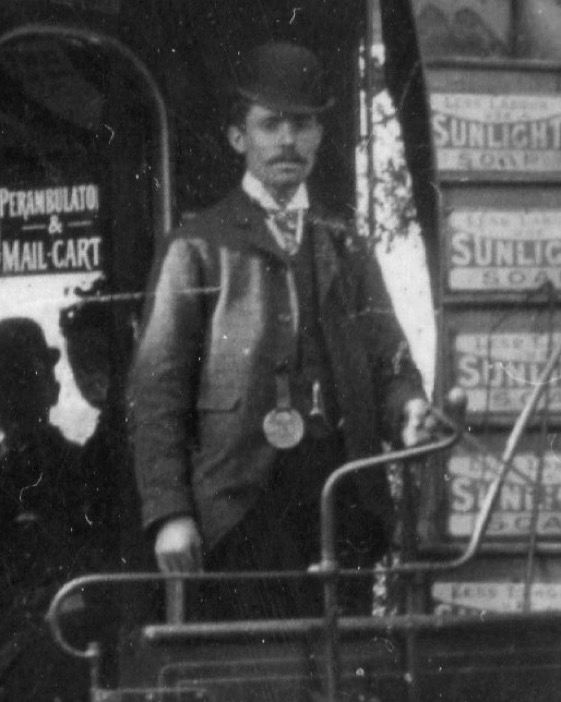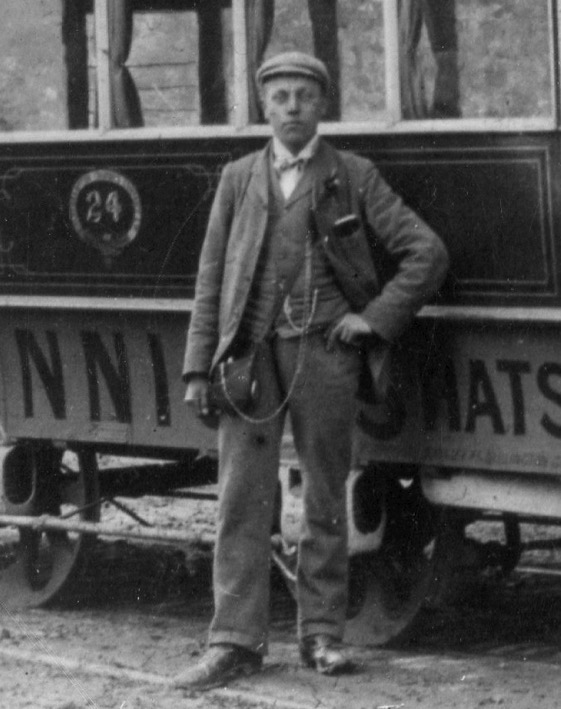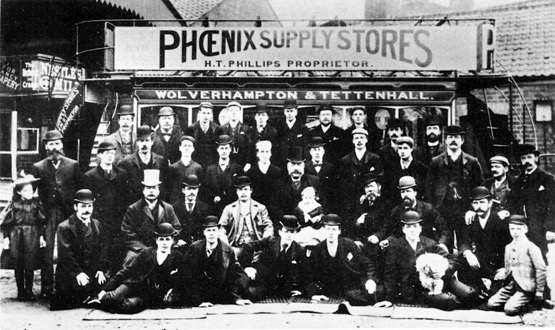Wolverhampton Tramways Company
History
The Wolverhampton Tramways Company Limited, which intended to build a series of tramway lines centred on the town in its title, was registered on the 14th December 1876. Powers to build three horse-drawn, standard-gauge lines, as well as to seek powers for an extension to one of them, were granted on the 23rd July 1877 under the Wolverhampton Tramways Order, 1877.
Construction of the tramway commenced in early 1878 using the patented Kincaid system of rails (and supports). The system consisted of three lines: westwards from Queen Square in Wolverhampton, along Darlington Street and Tettenhall Road to Newbridge, just short of Tettenhall proper (opened 1st May 1878); eastwards from Queen Street via Horsley Fields and Willenhall Road to a terminus in Willenhall Market Place (opened 6th June 1878); and southeastwards from Queens Street, along Pipers Row, Bilston Street, Bilston Road, and Wellington Road, to a terminus outside Bilston Town Hall (opened mid-July 1878).
Further powers were obtained under the Wolverhampton Tramways (Extension) Order of 1878, to build an extension from Bilston, along Oxford Street and High Street to a terminus at the junction of the latter with Holyhead Road in Moxley. The line was opened in August 1879, and took the company's system to its final extent of 8.69 miles. Although the South Staffordshire and Birmingham District Steam Tramways Company opened a short steam tramway line from Darlaston Bull Stake to Moxley — on or about the 21st January 1884 — the tracks were not connected as the steam tramway was built to the narrower gauge of 3ft 6ins.
The WTCo had always harboured plans to operate steam traction on its tramway, and duly obtained powers to do so in 1880 under the Wolverhampton Tramways (Mechanical Power) Order of 1880. Trials of a Hughes-built steam tram took place in late December 1880 and early 1881, which resulted in the Board of Trade licensing the use of steam traction for six months. Steam-hauled services began around May 1881 on the company's Tettenhall line, and proved to be highly successful, both from the company's and the populace's perspective, especially as they obviated the need for the use of a trace horse (also known as a tip horse) up the steep incline on Darlington Street. Unfortunately, and despite a significant local outcry, the council had other ideas, and successfully objected to the renewal of the licence, the last steam tram service running on or just before the 2nd November 1881.
The company now settled down to a profitable existence operating around twenty horse trams, several of which it either rebuilt of replaced over the course of its existence. By the middle of the 1890s, however, the company was forced to turn its focus to the future, given that Wolverhampton Corporation had a right to buy the lines within its municipal boundary 21 years after the passing of enabling act (i.e., in 1898). With this date looming, the company tried various inducements aimed at persuading the corporation to postpone its right to buy, but was not successful.
In 1896, the British Electric Traction Company, which was developing ambitious plans for a large 3ft 6ins-gauge electric tramway system centred on the Black Country and Birmingham, began negotiations with the various local authorities and tramway companies, in order to gain their support and also, deferment of the dates on which the authorities' had the right to buy the tramways within their respective municipal boundaries. In 1897, the BETCo promoted its Wolverhampton and District Tramways bill, which would have given it powers to acquire and convert the tramways of the WTCo, the Dudley and Wolverhampton Tramways Company, and the South Staffordshire Tramways Company. Unfortunately, it could not overcome the plethora of objections and demands raised by Wolverhampton Corporation, so had to withdraw the bill. The BETCo made two further attempts to appease the corporation (in May 1897 and January 1898), finally reaching agreement on all bar one point — the high price demanded by the corporation for municipally generated electricity — which proved to be a step too far for the company.
In July 1898, following its failure to reach agreement with the BETCo, Wolverhampton Corporation decided to purchase the tracks within the borough, and to seek powers to build and operate an electric tramway system. The latter, which were granted on the 9th August 1899 — under the Wolverhampton Corporation Act, 1899 — included all the WTCo's Tettenhall line, as well as substantial portions of the Willenhall and Bilston lines, to the municipal boundary at Deans Road (Heath Town Urban District Council) and Stow Heath Lane (Bilston Urban District Council), respectively. Whilst awaiting its powers, the corporation served notice on the WTCo — on the 6th October 1898 — of its intention to purchase the lines within its boundary.
The BETCo also pressed ahead with its own plans, reaching agreement with other authorities, as well as the existing horse and steam tramway companies in the area, including the WTCo, which it gained control of in 1898. On the 23rd January 1899, the WTCo and the BETCo signed a formal agreement in which the latter agreed to purchase the former's lines outside the Wolverhampton municipal boundary (on the same date as the corporation), and to take over powers that the WTCo would seek to convert them to 3ft 6ins-gauge and electric traction. The latter powers, under the Wolverhampton Tramways Order, 1899, were granted on the 9th August 1899.
Despite much negotiation, the corporation and the WTCo (and hence the BETCo) could not agree on the price to be paid for the lines and assets of the WTCo within the municipal boundary. After resorting to arbitration, a price was set and the tramway was finally handed over to the corporation (and the remainder to the BETCo) on the 1st May 1900. Whilst the corporation and the BETCo endeavoured to keep the horse tram services running from each end of the two lines that had been divided (Willenhall and Bilston), there now arose the thorny issue of the municipal boundary, which actually ran down the centre of the road on each route for around half a mile. This meant that on each line, and for several hundred yards, one rail of the horse tramway track was within Wolverhampton, whilst its partner was in that of the neighbouring Urban District Councils. Various sensible solutions were proposed, primarily by Bilston UDC, but Wolverhampton Corporation dug its heels in, refusing point blank to allow the BETCo to operate any service within the borough. This resulted in the farcical situation of passengers having to walk around half a mile on each line, from one operator's trams to the other's. This situation did not, however, last long, as the BETCo quickly substituted horse buses on the Willenhall line (on the 2nd June 1900), with the Bilston line following in September. This brought operation of the former WTCo horse tramway lines outside Wolverhampton to an end.
Meanwhile, the BETCo obtained new powers to build further 3ft 6ins-gauge electric tramway lines centred on Bilston; these were approved under the South Staffordshire Light Railway Order, 1900 (on the 11th August), and the South Staffordshire Light Railway (Extensions) Order, 1900 (on the 1st September 1900).
On the 17th December 1900, the BETCo set up a new subsidiary — Wolverhampton District Electric Tramways Limited — to take over the lines that it had acquired from the WTCo and the D&WTCo, as well as those that it intended to build under the South Stafford Staffordshire Light Railway Orders.
The WTCo was formally wound up on the 11th March 1901, the last horse services over its former tracks — operated by Wolverhampton Corporation on the Willenhall route — being withdrawn on the 24th January 1904.
Uniforms
In common with the majority of horse tramways in the British Isles, uniforms were never issued to tramcar crews during the company's tenure (1878 to 1900). Although attire was therefore informal, it does, however, appear that the company expected certain standards to be met, as photographs clearly show that drivers and conductors were reasonably smartly turned out, in heavy-duty trousers, jackets and waistcoats, along with white shirts, ties, and the fashionable headgear of the day, bowler hats for drivers and flat cloth caps for conductors.
The second photograph below clearly shows that drivers were issued with a round metal licence badge, probably brass, which was suspended by a leather strap; these were probably issued by Wolverhampton Watch Committee from late 1899 onwards.
Surviving records indicate that the company employed twelve drivers and twelve conductors, along with one inspector and one trace-horse boy. The staff photo shown below, which almost certainly includes the company's sole inspector, strongly suggests that a uniform was not issued to the holder of this grade.
Further reading
For more information on the tramways of Wolverhampton, see 'A History of Wolverhampton Transport, Volume I, 1833-1930'; S Webb and P Addenbrooke (Birmingham Transport Historical Group).
Images
Horse tram drivers and conductors
Conductor H Icke and driver J Brueton pose with Tramcar No 24 at the outer terminus of the Tettenhall route at Newbridge — photo undated, but certainly taken between 1892 (when this tramcar was delivered) and 1900 (when the company's lines and assets were sold to Wolverhampton Corporation and the British Electric Traction Company). With acknowledgement to 'A History of Wolverhampton Transport' (by Stanley Webb and Paul Addenbrooke) for the names of the two men depicted. Photo courtesy of the Tramways and Light Railway Society, with thanks to David Voice.
An enlargement of the above photograph showing Driver Brueton's smart attire, as well as superficial details of his licence badge, which is suspended from one of his jacket buttons.
Another enlargement of the first photograph above, this time showing Conductor Icke, who appears not to be wearing a licence, though it may possibly be attached to his cash bag.
A staff photograph taken outside one of the company's three depots, probably the main one in Darlington Street, Wolverhampton — photo undated, but given the presence of two top-hatted gentlemen, and the pristine condition of the tram, certainly taken to commemorate some significant event, possibly the purchase of four new horsecars in 1892. The bowler-hatted gents are almost certainly drivers, whereas their flat-capped counterparts are more than likely conductors. Photo courtesy of the Tramways and Light Railway Society, with thanks to David Voice.